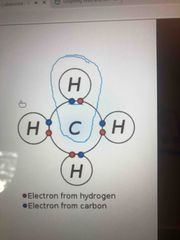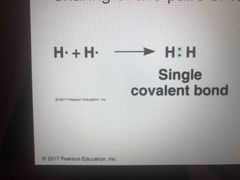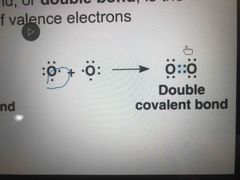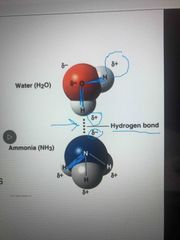![]()
![]()
![]()
Use LEFT and RIGHT arrow keys to navigate between flashcards;
Use UP and DOWN arrow keys to flip the card;
H to show hint;
A reads text to speech;
43 Cards in this Set
- Front
- Back
|
Matter |
Consist of chemical elements in pure form and in combinations called compounds Organisms are composed of matter Anything that takes up space |
|
|
Element |
A substance that cannot be broken down to other substances by chemical reactions |
|
|
Compound |
Sunstance consisting of two or more elements in a fixed ratio Sodium + chlorine= sodium chloride aka salt |
|
|
Essential elements |
About 20-20% of the 92 elements Required for life Carbon, hydrogen, oxygen, and nitrogen make up 96% of matter |
|
|
Trace elements |
Needed by an organism in minute quantities making up about 4 % Some like iron are needed by all forms, others by just some forms of life Still an essential element |
|
|
Atom |
Smallest unit of matter that retains the properties of an element Composed of subatomic particles |
|
|
Subatomic particles |
Neutrons-neutral Protrons-positive charge Electrons-negative charge |
|
|
Atomic nucleus |
Made up ofprotons and neutrons Electrons form cloud of negative charge around the nucleus (2 electrons) Neutron and protrons mass are almost identical and measured in daltons |
|
|
Dalton |
Mass of 1.7x10-24 |
|
|
What make an element an element? |
The number of protons Or the atomic number |
|
|
Atomic nunber |
Number of protons in its nucleus |
|
|
Mass number |
Sum of protons plus neutrons in the nucleus |
|
|
Atomic mass |
Atoms total mass |
|
|
Isotopes |
Same number of protons but have different neutrons Carbon has different isotopes |
|
|
Radioactive isotopes |
Decay spontaneously giving off particles and energy Aka transmute and end up with a different number of protons which changes the element |
|
|
Radioactive tracers |
Can be used to track atoms through metabolism Used a diagnostics tools in medicine Can be used in combination with imaging instruments |
|
|
Energy |
The capacity to cause change |
|
|
Potential energy |
Energy that matter has bc of its location or structure Gravity around earth Electrons of an atom differ in their amts of potential energy due to their distance from the atomic nucleus The farther the electron is, the more potential energy it has |
|
|
Electron shells |
An electrons state of potential energy aka its potential energy They can jump to other shells but it takes more energy and you can release energy as you move them in First: has lowest energy, most stable Second: higher Third: highest |
|
|
Electron distribution |
If you have two protons, then you have two electrons which fills first outer shell. Then you can fill next shell and so on. The first shell can only have two electrons The shells after hold up to 8 electrons |
|
|
Valence shell |
The outer shell Valence electrons are there Elements that have similar number of electrons in their outer shell, behave in a chemically similar way (ie: hydrogen, lithium, sodium all have one electron I their outer shell) |
|
|
Noble gases and chemically inert |
All elements want to fill their valence shell Chemicals that are full do not react much chemically because they are “satisfied” Neon, argon examples |
|
|
Electron orbital |
A 3 dimensional space where electron is found 90% of the time Each shell consists of a specific number of orbitals These shapes hold them in pairs and allow them to be as far as part as they can be Influence the shape of a molecule |
|
|
Chemical bonds |
Atoms with incomplete valence shells can share or transfer valence electrons with certain other atoms When this happens, atoms usually stay close together, held by attraction Can vary in strength Varieties of types of chemical bonds |
|
|
Covalent bonding |

Sharing of valence electrons between two atoms Strongest bond is when all valence shell is full A molecule consists of 2 or more atoms sharing a covalent bond |
|
|
Single bond |

Sharing of one pair of valence electrons |
|
|
Double covalent bond |

Sharing 2 pairs of valence electrons |
|
|
Atom’s valence |
Binding capacity How many electrons that are not paired (O has 6 valence electrons, two are not paired so oxygen’s valence is 2) |
|
|
Van der waal interaction |
Electrons are not evenly distributed and may accumulate by chance in one molecule Temporary dipole Geicko foot |
|
|
Electronegativity |
An atoms attraction for the electrons in a covalent bond Atoms in a molecule attract electrons to varying degrees The more protons and the less shells=more electronegativity Electronegativity increases as you go left to right on the periodic table because more protons are added to the atomic nucleus Adding more shells makes atoms less electronegativity Oxygen |
|
|
Nonpolar covalent bond |
Atoms share the electron equally |
|
|
Polar covalent bond |
One atom is more electronegative and they do not share equally Causes partial positive or partial negative charge for each atom or molecule Tends to be colder |
|
|
Ionic bond |
An attraction btw a cation and an anion Due to strong electronegativity, some atoms can strip electrons from bonding partners This allows for some atoms to lose an electron which can eliminate their valence shell and now they are “full” |
|
|
Cation |
A positively charged ion |
|
|
ionic compounds |
Compounds formed by ionic bonds compounds Highly charged Aka salt Different salts have different ratios Often found in nature as crystals |
|
|
ionic compounds |
Compounds formed by ionic bonds compounds Aka salt Different salts have different ratios Often found in nature as crystals |
|
|
Hydrogen bond |

When hydrogen covalently bonded to an electronegative is attracted to another Two molecules bonded Oxygen and nitrogen are most common in living cells Your dna is held together by hydrogen bonds |
|
|
Van der waal interaction |
Electrons are not evenly distributed and may accumulate by chance in one molecule Temporary dipole Partial charge creates a weak charge charge interaction Geicko foot |
|
|
Molecular shape and function |
A molecules size and shape are key to function Shape Determined by position of its atoms orbitals In covalent bonds, the s and p orbitals hybridize creating specific molecular shapes |
|
|
Chemical reactions |
Make and break chemical bonds All reactions are reversible: products became reactants |
|
|
Reactants |
Starting molecules of a chemical reaction |
|
|
Products |
The final molecules of the chemical reaction |
|
|
Chemical equilibrium |
Happens when the reverse and forward reactions happen at the same rate Does not mean the number of molecules are equal The relative concentrations of reactants and products do not change |

